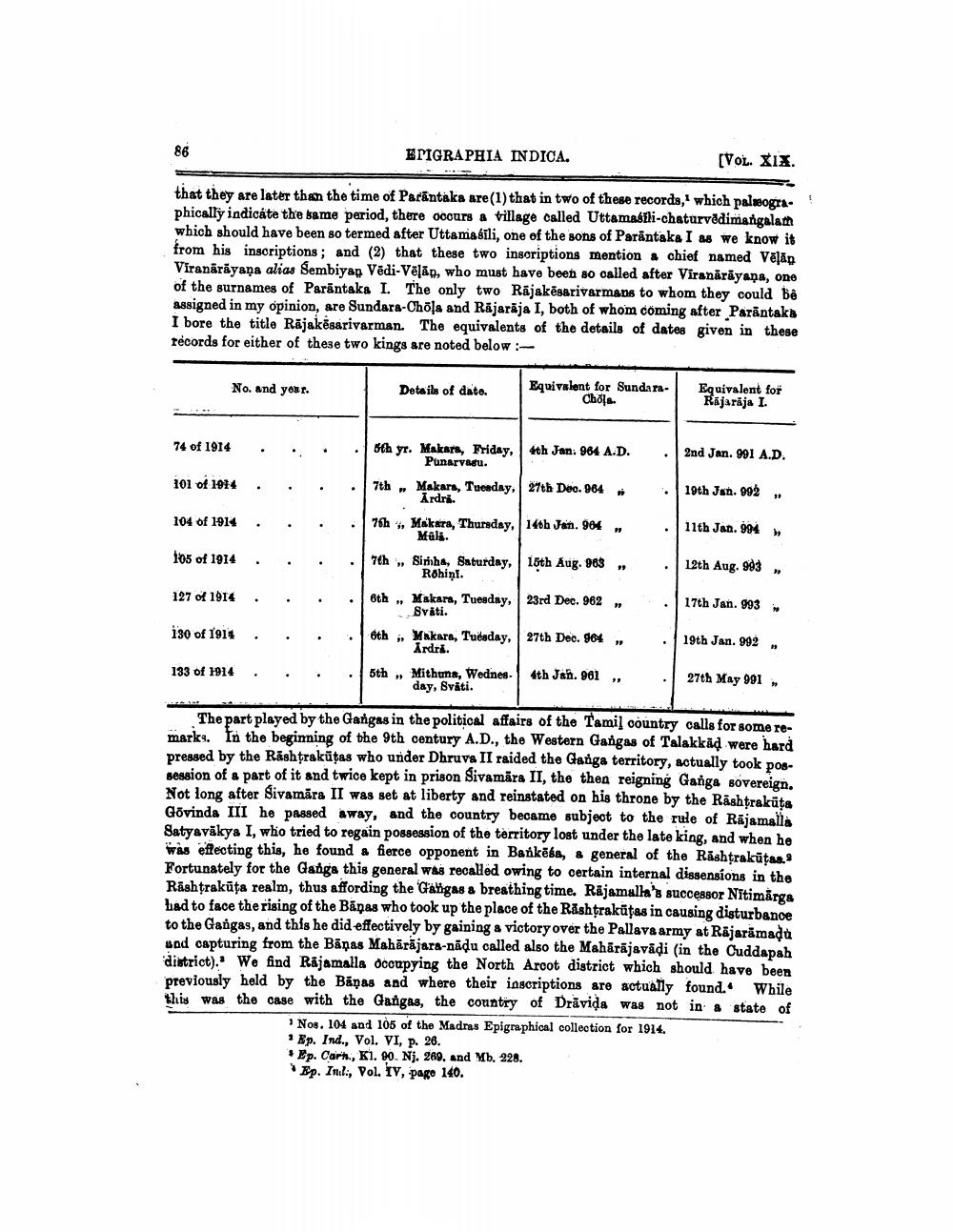________________
EPIGRAPHIA INDICA.
(VOL. XIX.
!
that they are later than the time of Parantaka are(1) that in two of these records, which palaeogra phically indicate the same period, there oocurs a Village called Uttamasili-chaturvedimangalath which should have been so termed after Uttamašili, one of the sons of Parantaka I as we know it from his inscriptions; and (2) that these two inscriptions mention a chief named Vélan Viranārāyaṇa alias Sembiyan Vēdi-Vēļān, who must have been so called after Viranārāyaṇa, one of the surnames of Parantaka I. The only two Rājakēsarivarmans to whom they could be assigned in my opinion, are Sundara-Chola and Rajarāja I, both of whom coming after Parantaka I bore the title Rājakësarivarman. The equivalents of the details of dates given in these records for either of these two kings are noted below :
No. and your.
Details of date.
Equivalent for Sundara
Chole
Equivalent for Rajaraja I.
.
74 of 1914
.
.
.
2nd Jan. 991 A.D.
101 of 1914
.
.
19th Jan. 992
.
104 of 1914
.
ilth Jan. 994
105 of 1914
.
.
5th yr. Makars, Friday, 4th Jan:
Punarvasu. 7th. Makars, Tuesday, 27th Dec. 964
Ardri. 76 Makara, Thursday, 14th Jan. 904
Müls. 7th, Sinha, Saturday, 16th Aug. 983,
Rohiņi. oth. Makara, Tuesday, 23rd Dec. 962
Sväti. i Makars, Tuesday, 27th Dec. 964,
Ardri. sth. Mithuna, Wednes. 4th Jan. 961 ,
day, Sväti.
12th Aug. 993,
127 of 1914
.
.
·
17th Jan. 993
130 of 1914
.
.
19th Jan. 992
133 of 1914
.
.
.
.
27th May 991
The part played by the Gangas in the political affairs of the Tamil country calls for some remarks. In the beginning of the 9th century A.D., the Western Gangas of Talakkad were hard pressed by the Rashtrakūtas who under Dhruva II raided the Ganga territory, actually took possession of a part of it and twice kept in prison Sivamāra II, the then reigning Ganga sovereign. Not long after Sivamāra II was set at liberty and reinstated on his throne by the Rashtraküts Govinda III he passed away, and the country became subject to the rule of Rājamalla Satysyäkya I, who tried to regain possession of the territory lost under the late king, and when he was effecting this, he found a fierce opponent in Bankēta, & general of the Rashtrakūtas. Fortunately for the Ganga this general was recalled owing to certain internal dissensions in the Rashtrakūta realm, thus affording the 'Gangas a breathing time. Rajamalla's successor Nitimarga Lad to face the rising of the Bānas who took up the place of the Rashtrakūtas in causing disturbance to the Gangas, and this he did effectively by gaining a victory over the Pallava army at Rajaramada uod capturing from the Bānas Mahārājara-nādu called also the Mahārājavādi (in the Cuddapah district).' We find Rajamalla occupying the North Arcot district which should have been previously held by the Båpas and where their inscriptions are actually found. While this was the case with the Gangas, the country of Drāvida was not in a state of
Nos. 104 and 105 of the Madras Epigraphical collection for 1914. * Bp. Ind., Vol. VI, p. 26. Ep. Carh., Kl. 90. Nj. 269. and Mb. 228. Ep. Inili, Vol. IV, Pago 140.




